History
 These days, automation is commonplace. We have apps on our phones that can handle our payments at the register, and even let us skip the register and pay as we walk out the door. We have apps for home security, and even to turn things on and off from miles away. All that seems so normal to us these days, but imagine this kind of thing in 1956. I know that it sounds bizarre, but someone did think of a form of automation, even if it would seem primitive these days.
These days, automation is commonplace. We have apps on our phones that can handle our payments at the register, and even let us skip the register and pay as we walk out the door. We have apps for home security, and even to turn things on and off from miles away. All that seems so normal to us these days, but imagine this kind of thing in 1956. I know that it sounds bizarre, but someone did think of a form of automation, even if it would seem primitive these days.
On July 19, 1956, a model named Joan Lockwood selected items from a glass case at a completely automated section of a supermarket at the 30th Annual IGA Food Store Convention at the Waldorf-Astoria in New York. She put a large round “key” in a matching slot while she pressed buttons to make her selection. The items she selected were recorded on a tape inside the key. The machine tabulated the amount due on the purchases at the same time. It was just one of the systems that was proposed for supermarkets. The plan was to implement the system in the fall of 1956 in key  US cities. The three types of automation would be push-button selection in the store, checking of items on special cards at home or in the store, for electronic delivery by conveyor belt to the counter, and after-hours and Sunday automatic shopping of limited last minute supplies at coin machine units outside stores.
US cities. The three types of automation would be push-button selection in the store, checking of items on special cards at home or in the store, for electronic delivery by conveyor belt to the counter, and after-hours and Sunday automatic shopping of limited last minute supplies at coin machine units outside stores.
The shopping method that IGA Food Stores envisioned didn’t really seem plausible, and for an entire store, but then these days you can order online and pick up your order at Walmart, or have Target deliver it to you. I’m sure that wasn’t exactly what IGA had in mind with there system, and indeed it wasn’t what came of it at that time, but it did start the ball rolling for a type of shopping that we all take for granted these days…the vending machine. Of course, the vending machine can’t distribute everything, but it has gotten to the point of even being able to distribute foods that must be kept cold. It’s a very different type of vending machine than the old IGA machine, but it is most likely the brainchild of that old IGA system.
 Many people have disappeared over the years…some were kidnapped and likely murdered, some were lost on a trip and no one knew where they ended up. Some even fell into a sinkhole or crevasse on a glacier, but while many of these were seen by someone one last time, none that I have ever heard of simply vanished into thin air in front of witnesses…at least not until I read about Orion Williamson.
Many people have disappeared over the years…some were kidnapped and likely murdered, some were lost on a trip and no one knew where they ended up. Some even fell into a sinkhole or crevasse on a glacier, but while many of these were seen by someone one last time, none that I have ever heard of simply vanished into thin air in front of witnesses…at least not until I read about Orion Williamson.
Orion Williamson was a farmer who lived with his wife and son in his farmhouse in Selma, Alabama in 1854. One sunny July afternoon, he was sitting on his front porch with his family. His neighbors, Armour Wren and his son, James were passing by. Orion stood up to move his grazing horses to the shade. He briefly stopped to pick up a small stick, which he absently swished back and forth as he walked in the ankle-deep grass. Orion waved to his neighbors, took one more step, and vanished into thin air. Had one witness seen this event, it could be easily disputed as a way to explain a man who had abandoned his family, but four witnesses…well, that was much harder to dispute.
Hardly able to believe their eyes, the Williamsons and the Wrens ran to the spot Orion disappeared in and searched for any sign of him. They found none. Most of the grass in the spot was gone too. There was no hole that he could have fallen into, no cliff he could have fallen down, and no burned area that might have suggested spontaneous combustion…just thin air, and missing grass. After hours of futile searching, Orion’s shocked family and neighbors went for help. A search party of three hundred men was formed, and they carefully and repeatedly combed every inch of the field. Later, bloodhounds joined the search. No sign of Orion materialized, even though the effort continued well into the night.
As news of the inexplicable vanishment spread, more volunteers and a team of geologists arrived. They dug up the field, looking for signs of instability. They reached solid rock a few feet below the surface. No holes, crevices, or cave-ins, nothing that could explain the event. Mrs Williamson and her son reported that they could hear Orion’s voice calling for help for weeks afterwards, ever growing fainter and fainter. Each time they would rush out onto the field, only to find nothing. Gradually, Orion’s voice faded into a mere whisper, then disappeared forever. It was almost as if he had moved into an alternate dimension, like a time warp or something. After massive searching turned up no signs of Williamson, the judge declared Orion dead. The following spring, it is said, a circle of dead grass appeared to mark the spot of the unlucky farmer’s disappearance.
The German scientist, Maximilian Hern, author of the book Disappearance and Theory Thereof, speculated that Orion walked into a spot of “universal ether,” because he believed these places lasted a few seconds and could completely destroy all matter within them. Still, that does not explain his family hearing his voice, assuming it was not imagined. Another scientist theorized a magnetic field had disintegrated Orion’s atomic structure and  sent him into another dimension. That might explain the alternate dimension theory, because I would never buy into the theory that “goblins did it,” since I don’t believe in goblins.
sent him into another dimension. That might explain the alternate dimension theory, because I would never buy into the theory that “goblins did it,” since I don’t believe in goblins.
Years later, a traveling salesman named McHatten rewrote the Williamson disappearance. In his version of the story, Orion’s name became David Lang, the place changed to Gallatin and the date was moved to 1880. Even though the Lang story was a fictional account, apart from the basic facts, Newspapers began to present it as truth in newspaper articles and books…by authors who didn’t do their homework anyway. Consequently, the fictional story is better known than the real vanishment behind it.
 Emma Gatewood was a survivor. When I read the first few lines about her, I thought her story was remarkable, but as I read the whole story, I realized just how remarkable she really was. Emma’s married life was pure torture, with the exception of her children, whom she dearly loved. Emma married her husband, Perry Clayton Gatewood, a 26 year old school teacher, turned farmer, when she was just 19 years old. He was a horrible man, who immediately put her to work building fences, burning tobacco beds, and mixing cement, in addition to her household chores. Three months after their wedding, he started to beat her, a practice he continued until, one day in 1939, he broke her teeth, cracked one of her ribs and bloodied her face. Women didn’t have as many options back then, so Emma was stuck. Because Emma threw a sack of flour at him, the police came and arrested her, not him, and put her in jail. The next day, when the mayor saw her battered face, he took her to his own home, where she remained under his protection until she got back on her feet.
Emma Gatewood was a survivor. When I read the first few lines about her, I thought her story was remarkable, but as I read the whole story, I realized just how remarkable she really was. Emma’s married life was pure torture, with the exception of her children, whom she dearly loved. Emma married her husband, Perry Clayton Gatewood, a 26 year old school teacher, turned farmer, when she was just 19 years old. He was a horrible man, who immediately put her to work building fences, burning tobacco beds, and mixing cement, in addition to her household chores. Three months after their wedding, he started to beat her, a practice he continued until, one day in 1939, he broke her teeth, cracked one of her ribs and bloodied her face. Women didn’t have as many options back then, so Emma was stuck. Because Emma threw a sack of flour at him, the police came and arrested her, not him, and put her in jail. The next day, when the mayor saw her battered face, he took her to his own home, where she remained under his protection until she got back on her feet.
Emma and Perry had 11 children, and unfortunately, the treatment of their mother was not hidden from them. Nevertheless, the story of Emma’s abuse at the hands of her husband went untold for more than a 50 years. In 2014, a newspaper reporter named Ben Montgomery, Emma’s great grand nephew, told her story in his book, “Grandma Gatewood’s Walk.” Emma Rowena (Caldwell) Gatewood passed away on June 04, 1973 in Gallipolis, Ohio, of an apparent heart attack, at the grand old age of 85, having accomplished much since her birth on  October 25, 1887, in Gallia County, Ohio. Her father, Hugh Caldwell, a farmer, had lost a leg after being wounded in the Civil War and in his depression, turned to a life of drinking and gambling. Her mother, Evelyn (Trowbridge) Caldwell, raised the couple’s 15 children, who slept four to a bed in the family’s log cabin.
October 25, 1887, in Gallia County, Ohio. Her father, Hugh Caldwell, a farmer, had lost a leg after being wounded in the Civil War and in his depression, turned to a life of drinking and gambling. Her mother, Evelyn (Trowbridge) Caldwell, raised the couple’s 15 children, who slept four to a bed in the family’s log cabin.
In an interview with her children, Montgomery, who worked for The Tampa Bay Times in Florida. In his research for the book, her surviving children spoke with him and entrusted him with her journals, letters, and scrapbooks. In that material he found stark references to what she had withheld from news interviewers: that her husband had nearly pummeled her to death several times. During one beating, she wrote, he broke a broom over her head. Her children told Montgomery that their father’s sexual hunger had been insatiable and that he forced himself on their mother several times a day. He made their lives a nightmare for years.
The woods became a place of solace and safety for Emma, who would often escape to them amid her husband’s rants. She came to view the wilderness as protective and restorative. In 1937 she left him and moved in with relatives in California. She was forced to leave behind two daughters, ages 9 and 11, who were still at home. Emma knew her husband would not beat the girls, and she could not afford to take them with her. She wrote to the girls to explain it to them, making sure not to leave a return address. In the letter, she wrote, “I have suffered enough at his hands to last me for the next hundred years.” Nevertheless, Emma couldn’t stand to be away from her girls any longer, so she returned after a few months. Her life became a prison after that. Her husband would not let her out of his sight. She later wrote that in 1938, he beat her “beyond recognition” 10 times. “For a lot of people the trail is a refuge,” Brian B. King, a publisher of guidebooks and maps for the Appalachian Trail Conservancy, said in a telephone interview. “But seldom is it a refuge for something as bad 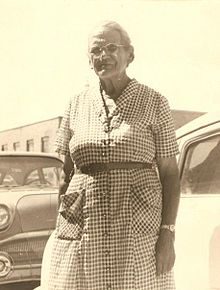 as that.” A short time later, her husband left for good, filed for divorce, which was granted in 1941, and he was out of her life.
as that.” A short time later, her husband left for good, filed for divorce, which was granted in 1941, and he was out of her life.
Emma’s hiking became a saving grace for her…she loved it. In 1949, she came across a National Geographic magazine article about the Appalachian Trail and became intrigued to learn in reading it that no woman had ever hiked it solo. In 1954, in her first attempt at hiking the Appalachian Trail, she started out in Maine, but broke her glasses, got lost, and was rescued by rangers, who told her to go home. Undaunted, she tried again in 1955, starting from Georgia this time. She was 67 years old, a mother of 11, a grandmother and even a great-grandmother when she became the first woman to hike the entire Appalachian Trail by herself in one season. She would go on to repeat the feat 2 more times. Soon everyone was calling her “America’s most celebrated pedestrian.” In 1959, Emma went on to conquer the 2,000 miles of the Oregon Trail, trekking alone from Independence, Missouri to Portland, Oregon.
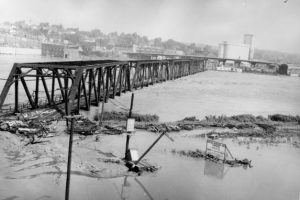 Rain…it waters the earth, and as we all know, without it, we could not survive. Nevertheless, as vital as water is to life on this planet, too much of it can be deadly. People can drink too much water, we can over-water our plants, and too much rain can bring flooding. Such was the case on July 13, 1951. Above-average rainfall began in June and continued through July 13th, dumping well over 25 inches on some areas in eastern Kansas. From July 9th to 13th, nearly 6 inches of rain fell. The Kansas, Neosho, and Verdigris rivers began taking on more water than their normal carrying capacity a couple of days into the storm, but as the rain persisted, flooding began all over the region.
Rain…it waters the earth, and as we all know, without it, we could not survive. Nevertheless, as vital as water is to life on this planet, too much of it can be deadly. People can drink too much water, we can over-water our plants, and too much rain can bring flooding. Such was the case on July 13, 1951. Above-average rainfall began in June and continued through July 13th, dumping well over 25 inches on some areas in eastern Kansas. From July 9th to 13th, nearly 6 inches of rain fell. The Kansas, Neosho, and Verdigris rivers began taking on more water than their normal carrying capacity a couple of days into the storm, but as the rain persisted, flooding began all over the region.
The major towns of Manhattan, Topeka and Lawrence took the biggest hit. As is 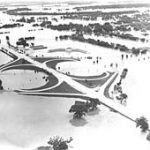 the case in any area where absorption is hampered by cement and asphalt, the rain could not soak in, and the ground was are already saturated anyway. The rain had nowhere to go, and the area was in trouble. Prior to the July 13 river crest, previous highs were dwarfed by four to nine feet. Two million acres of farmland were lost to the flood, which would trigger a crisis of its own, by a shortage of food. The flooding also caused fires and explosions in refinery oil tanks on the banks of the Kansas River. Passenger trains traveling through the area were stuck for nearly four days. In all, $760 million in damages were caused by the flood, and 500,000 people were left homeless, while 24 people died in the disaster. It was the greatest destruction from flooding in the Midwestern United States up to that time.
the case in any area where absorption is hampered by cement and asphalt, the rain could not soak in, and the ground was are already saturated anyway. The rain had nowhere to go, and the area was in trouble. Prior to the July 13 river crest, previous highs were dwarfed by four to nine feet. Two million acres of farmland were lost to the flood, which would trigger a crisis of its own, by a shortage of food. The flooding also caused fires and explosions in refinery oil tanks on the banks of the Kansas River. Passenger trains traveling through the area were stuck for nearly four days. In all, $760 million in damages were caused by the flood, and 500,000 people were left homeless, while 24 people died in the disaster. It was the greatest destruction from flooding in the Midwestern United States up to that time.
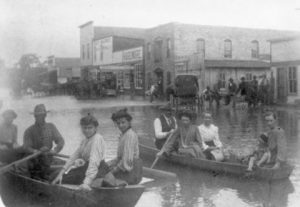
A often happen, tragedy brings change. Following the great 1951 flood, a series of reservoirs and levees were constructed all over the area. In 1993, these were credited with minimizing the damage from another record flood. Water is an element that is necessary for life, but lest we forget, water in an overabundance can kill and destroy. People need to pay attention to evacuation warnings, and get out of an area where a flood is eminent. You may lose some things, but if you leave the area, you will most likely to walk away unscathed, and as we know, things can be predicted, and those who head out of unsafe areas will most likely live to tell the tale.

 In a war, there are many heroes…some whose acts of courage and selflessness were so amazing that many felt they needed to receive a different medal…one that paid homage to the incredible things they did. Often these medals were even given posthumously because the brave act of the hero, cost the recipients their lives. Before 1861, no such medal existed. President Abraham Lincoln didn’t think that was right. There were many brave soldiers, and while not all brave acts would qualify for the medal of honor, the most self sacrificing of them would…the ones who set aside their own safety to protect the lives of others.
In a war, there are many heroes…some whose acts of courage and selflessness were so amazing that many felt they needed to receive a different medal…one that paid homage to the incredible things they did. Often these medals were even given posthumously because the brave act of the hero, cost the recipients their lives. Before 1861, no such medal existed. President Abraham Lincoln didn’t think that was right. There were many brave soldiers, and while not all brave acts would qualify for the medal of honor, the most self sacrificing of them would…the ones who set aside their own safety to protect the lives of others.
For that reason, President Abraham Lincoln signed into law a measure calling for the awarding of a US Army Medal of Honor, in the name of Congress, “to such noncommissioned officers and privates as shall most distinguish themselves by their gallantry in action, and other soldier-like qualities during the present insurrection.” The previous December, Lincoln had approved a provision creating a US Navy Medal of Valor, which was the basis of the Army Medal of Honor created by Congress on July 12, 1862. War puts men and women into situations whereby the only choices are kill or be killed. That can be a scary proposition. These soldiers do not do what they do in order to receive a medal. In fact, a medal rarely crosses their minds at all. The first US Army soldiers to receive what would become the nation’s highest military honor were six members of a Union raiding party who in 1862 penetrated deep into Confederate territory to destroy bridges and railroad tracks between Chattanooga, Tennessee, and Atlanta, Georgia.
In 1863, the Medal of Honor was made a permanent military decoration available to all members, including commissioned officers, of the US military. It is conferred upon those who have distinguished themselves in actual combat at risk of life beyond the call of duty. Since its creation, during the Civil War, more than 3,400 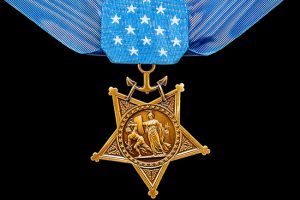
 men and one woman, Dr Mary Walker, have received the Medal of Honor for heroic actions in US military conflict. These people gave whatever it took to perform their duties. They were the best of the best, and the medal of honor was the best honor we could bestow on them. Of course, in Lincoln’s time, there was no air force, so that medal came later, as did the medals from the other branches of service, including the Coast Guard.
men and one woman, Dr Mary Walker, have received the Medal of Honor for heroic actions in US military conflict. These people gave whatever it took to perform their duties. They were the best of the best, and the medal of honor was the best honor we could bestow on them. Of course, in Lincoln’s time, there was no air force, so that medal came later, as did the medals from the other branches of service, including the Coast Guard.
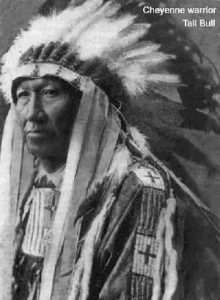 The Dog Soldiers were an elite group Indian warriors. Originally, they fought against other Indian tribes, but in the 1860s they increasingly became one of the biggest enemies of the United States Government in what became the bloody Plains Indian Wars. Tall Bull was a prominent leader of the Cheyenne Dog Soldier Warrior Society. He was the most distinguished of several Cheyenne warriors who bore the hereditary name over the years. Because it was an honorable name to inherit, the name was passed down many times, to many warriors over the years.
The Dog Soldiers were an elite group Indian warriors. Originally, they fought against other Indian tribes, but in the 1860s they increasingly became one of the biggest enemies of the United States Government in what became the bloody Plains Indian Wars. Tall Bull was a prominent leader of the Cheyenne Dog Soldier Warrior Society. He was the most distinguished of several Cheyenne warriors who bore the hereditary name over the years. Because it was an honorable name to inherit, the name was passed down many times, to many warriors over the years.
In October 1868, Tall Bull and his Dog Soldiers viciously attacked an American cavalry force in Colorado. The following winter in Oklahoma, they confronted General Philip Sheridan’s forces. Near the Washita River, Sheridan’s Lieutenant Colonel George Custer attacked a peaceful Cheyenne village under Chief Black Kettle. More than 100 Cheyenne Indians were killed, and Custer’s soldiers brutally butchered more than 800 of their horses. However, Custer was forced to flee when Tall Bull and other chiefs camped in nearby villages began to mass for attack. Custer’s attack had badly weakened the Cheyenne, but Tall Bull refused to surrender to the White Man, under any circumstances. He was a warrior and he would fight to the bitter end.
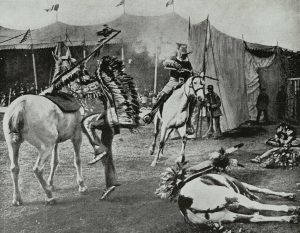 In the spring of 1869, Tall Bull and his Dog Soldiers took their revenge by staging a series of very successful attacks against the soldiers, who were searching for him. Determined to destroy the chief, the US Army formed a special expeditionary force under the command of General Eugene Carr. On July 11, 1869, Carr surprised Tall Bull and his warriors in their camp at Summit Springs, Colorado. In the battle that followed, Tall Bull was killed and the Dog Soldiers were overwhelmed. Without the dynamic leadership of their chief, the surviving Dog Soldiers’ resistance was broken. Although others in the Cheyenne nation continued to fight the US Army for another decade, they did so without the aid of their greatest warrior society and its leader…Tall Bull.
In the spring of 1869, Tall Bull and his Dog Soldiers took their revenge by staging a series of very successful attacks against the soldiers, who were searching for him. Determined to destroy the chief, the US Army formed a special expeditionary force under the command of General Eugene Carr. On July 11, 1869, Carr surprised Tall Bull and his warriors in their camp at Summit Springs, Colorado. In the battle that followed, Tall Bull was killed and the Dog Soldiers were overwhelmed. Without the dynamic leadership of their chief, the surviving Dog Soldiers’ resistance was broken. Although others in the Cheyenne nation continued to fight the US Army for another decade, they did so without the aid of their greatest warrior society and its leader…Tall Bull.
 There have been many inventions that were discovered by accident, but none was sweeter than the Chocolate Chip Cookie. My sister-in-law, Marlyce Schulenberg loved to make cookies, and she knew that I was partial to her chocolate chip cookies, but she didn’t invent them. We have to thank Ruth Graves Wakefield for that. It was one of apparently several “mistakes” Ruth made in the kitchen. We’ve all been there, but this mistake was not disastrous.
There have been many inventions that were discovered by accident, but none was sweeter than the Chocolate Chip Cookie. My sister-in-law, Marlyce Schulenberg loved to make cookies, and she knew that I was partial to her chocolate chip cookies, but she didn’t invent them. We have to thank Ruth Graves Wakefield for that. It was one of apparently several “mistakes” Ruth made in the kitchen. We’ve all been there, but this mistake was not disastrous.
Ruth and her husband, Kenneth owned Toll House Inn in Whitman, Massachusetts. Ruth prepared the recipes and cooked for the inn’s guests. One day in 1930, she had a problem. She was out of baker’s chocolate for her scrumptious Butter Drop Do cookies. She knew that her guests always looked forward to those cookies and would be upset if  she didn’t have any. She gave the matter some thought, and decided that she could just break up a bar of Nestle’s semisweet chocolate into tiny chunks and mixed them into the batter. She assumed that the chocolate would melt, spread into the dough as it baked, and create a chocolate-flavored cookie. Unfortunately, chocolate is a little be more resilient than that. The chunks melted…to a degree, but pretty much held their position in the cookie dough. When she took the cookies out of the oven, she noticed that the chocolate chunks only melted slightly, holding their shape and forming a creamy texture. It was too late to do anything else, so she served the cookies to her guests, who absolutely loved them.
she didn’t have any. She gave the matter some thought, and decided that she could just break up a bar of Nestle’s semisweet chocolate into tiny chunks and mixed them into the batter. She assumed that the chocolate would melt, spread into the dough as it baked, and create a chocolate-flavored cookie. Unfortunately, chocolate is a little be more resilient than that. The chunks melted…to a degree, but pretty much held their position in the cookie dough. When she took the cookies out of the oven, she noticed that the chocolate chunks only melted slightly, holding their shape and forming a creamy texture. It was too late to do anything else, so she served the cookies to her guests, who absolutely loved them.

Ruth’s chocolate chip cookies began attracting people from all over New England. After her recipe appeared in a Boston newspaper, Nestle gained a huge spike in sales. Everyone wanted Nestle’s semisweet chocolate bars to make Ruth Wakefield’s cookies. Andrew Nestle came up with a great marketing idea that would be beneficial for both of them. Nestle agreed to give Wakefield a lifetime supply of the chocolate in return for her recipe printed on every Nestle semisweet chocolate bar. Later, of course, they printed it on the bags of chocolate chips, because who wants to break up all that chocolate, when it could be done for you and placed in a bag. I don’t know of anyone who hasn’t had chocolate chip cookies in their lifetime, and we can all thank Ruth Wakefield and her cookie mistake for that scrumptious treat.
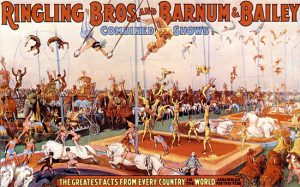 Most people have attended a circus at one time or another, although they are becoming a little more something from the past. Nevertheless, they used to be huge attractions, and when the circus came to town, almost the whole town turned out to watch the show. That was something that worked against the people of Hartford, Connecticut on July 6, 1944. At that time, Hartford was a city of approximately 13,000 people. The Independence Day festivities had just passed and now the circus was in town to continue the week’s excitement for the townspeople. The Ringling Brothers and Barnum Baily Circus was famous for its incredible show, held under a huge circus tent. At 8,000 people in attendance, about 2/3 of the town was there. It was going to be a great show, and the children of the town were beyond excited.
Most people have attended a circus at one time or another, although they are becoming a little more something from the past. Nevertheless, they used to be huge attractions, and when the circus came to town, almost the whole town turned out to watch the show. That was something that worked against the people of Hartford, Connecticut on July 6, 1944. At that time, Hartford was a city of approximately 13,000 people. The Independence Day festivities had just passed and now the circus was in town to continue the week’s excitement for the townspeople. The Ringling Brothers and Barnum Baily Circus was famous for its incredible show, held under a huge circus tent. At 8,000 people in attendance, about 2/3 of the town was there. It was going to be a great show, and the children of the town were beyond excited.
With the tent filled to capacity, a fire is the worst nightmare, but that is what they had. No one knows exactly what happened, and the 8,000 people inside really had no time in which to react. As panic spread as fact as the fire broke out under the big top of circus, killing 167 people and injuring 682. Two thirds of those who perished 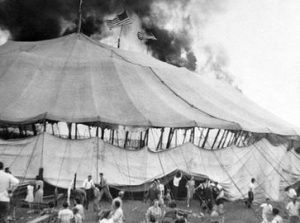 were children. The cause of the fire was unknown, but it spread at incredible speed, racing up the canvas of the circus tent. Suddenly, patches of burning canvas began falling on them from above, and a stampede for the exits began. People became trapped under fallen canvas, but most were able to rip through it and escape, but after the tent’s ropes burned and its poles gave way, the whole burning big top came crashing down, trapping those who remained inside. Within 10 minutes it was over, and some 100 children and 60 of their adult escorts were dead or dying.
were children. The cause of the fire was unknown, but it spread at incredible speed, racing up the canvas of the circus tent. Suddenly, patches of burning canvas began falling on them from above, and a stampede for the exits began. People became trapped under fallen canvas, but most were able to rip through it and escape, but after the tent’s ropes burned and its poles gave way, the whole burning big top came crashing down, trapping those who remained inside. Within 10 minutes it was over, and some 100 children and 60 of their adult escorts were dead or dying.
The fire investigation revealed that the tent had undergone a treatment with flammable paraffin thinned with three parts of gasoline to make it waterproof. These days, no on would consider using gasoline for such a purpose, but unfortunately at that time it was used. Ringling Brothers and Barnum and Bailey Circus eventually agreed to pay $5 million in compensation, and several of the organizers were convicted on manslaughter charges. In 1950, the cause was finally uncovered in the case when Robert D Segee of Circleville, Ohio, confessed to starting the Hartford circus fire. Segee claimed that he had been an arsonist since the age of six and that “an apparition of an Indian on a 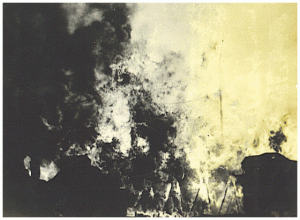 flaming horse often visited him and urged him to set fires.” In November 1950, Segee was convicted in Ohio of unrelated arson charges and sentenced to 44 years of prison time. The Hartford investigators raised doubts over his confession. Segee had a history of mental illness, and it could not be proven he was anywhere within the state of Connecticut when the fire occurred. Connecticut officials were also not allowed to question Segee, even though his alleged crime had occurred in their state. Segee, who died in 1997, denied setting the fire as late as 1994 during an interview. Because of this, many investigators, historians, and victims believe the true arsonist…if it was indeed arson…was never found.
flaming horse often visited him and urged him to set fires.” In November 1950, Segee was convicted in Ohio of unrelated arson charges and sentenced to 44 years of prison time. The Hartford investigators raised doubts over his confession. Segee had a history of mental illness, and it could not be proven he was anywhere within the state of Connecticut when the fire occurred. Connecticut officials were also not allowed to question Segee, even though his alleged crime had occurred in their state. Segee, who died in 1997, denied setting the fire as late as 1994 during an interview. Because of this, many investigators, historians, and victims believe the true arsonist…if it was indeed arson…was never found.

 For many years, my husband, Bob Schulenberg and I have gone to the Black Hills to celebrate Independence Day. It has been our tradition for about 30 years. This year, things got changed up a bit. Our daughter, Amy Royce and her husband Travis invited us to come to Washington to spend the holiday with them. We will be watching the fireworks display at Semiahmoo Bay on the 4th. Bob and I went there a couple of years ago when we spent Thanksgiving with Amy’s family. The bay is beautiful, and I’m sure it will be even more fun in the summertime warmth…although it wasn’t very cold in November. We have never seen fireworks set off over water, so that will definitely be something new, and something about which we are very excited.
For many years, my husband, Bob Schulenberg and I have gone to the Black Hills to celebrate Independence Day. It has been our tradition for about 30 years. This year, things got changed up a bit. Our daughter, Amy Royce and her husband Travis invited us to come to Washington to spend the holiday with them. We will be watching the fireworks display at Semiahmoo Bay on the 4th. Bob and I went there a couple of years ago when we spent Thanksgiving with Amy’s family. The bay is beautiful, and I’m sure it will be even more fun in the summertime warmth…although it wasn’t very cold in November. We have never seen fireworks set off over water, so that will definitely be something new, and something about which we are very excited.
Celebrating our nation’s independence has always been a favorite holiday for Bob and me. We love everything about it. The fireworks take my thoughts back to history lessons, of the Revolutionary War. The rockets shot at ships, and the fighting that took place because we were a nation ready to be our own country. The fighting was sometimes brutal, but it was necessary. The patriots willingly gave their lives for the cause of independence. The fighting took place on land and water, and yet we have never seen fireworks over the water…until now. In my mind, I can see the ships from the Revolutionary War out in the bay. I can imagine the fireworks are the rockets, and the war is real. Nevertheless, I am glad that it isn’t really real, because I would not want our soldiers to have to relive that, but I can feel like a mouse in the corner, watching as history unfolds in front of my eyes…at least I can imagine it.
Of course, the fireworks aren’t the real thing, but rather just reminder of what our nation and the soldiers who fought for our independence, went through. My imagination of happened is just that…a figment of my imagination, because those events are long in the past. Still, I don’t believe that we should ever forget the lessons of war. There is always a reason we go to war…a wrong that must be made right, tyranny that must be stopped, killing that must be squashed, and slaves who must be made free. Good nations don’t go to war for 
 evil purposes. I believe that the most important lesson to be taken away from any war, is that we must never trust our enemies, and even more importantly, we must never allow the enemy to infiltrate our nation and our government. Happy Independence Day to our great nation…the United States of America. Forever may our flag fly and forever may our nation stand.
evil purposes. I believe that the most important lesson to be taken away from any war, is that we must never trust our enemies, and even more importantly, we must never allow the enemy to infiltrate our nation and our government. Happy Independence Day to our great nation…the United States of America. Forever may our flag fly and forever may our nation stand.

 When we think of space exploration, I think most of us think about the moon or the International Space Station, but NASA has really done more exploring of other areas that it has of the moon. One such mission was NASA’s Cassini spacecraft, and the Huygens probe. Cassini launched in 1997, along with ESA’s Huygens probe. It was a joint endeavor of NASA, the European Space Agency, or ESA, and the Italian Space Agency. For six months in 2000, the spacecraft contributed to studies of Jupiter, before continuing on to its destination…Saturn, on June 30, 2004 and starting a string of flybys of Saturn’s moons. The Huygens probe was released later that year on Saturn’s moon Titan to conduct a study of the moon’s atmosphere and surface composition. In its second extended mission, Cassini made the first observations of a complete seasonal period for Saturn and its moons, flew between the rings and descended into the planet’s atmosphere.
When we think of space exploration, I think most of us think about the moon or the International Space Station, but NASA has really done more exploring of other areas that it has of the moon. One such mission was NASA’s Cassini spacecraft, and the Huygens probe. Cassini launched in 1997, along with ESA’s Huygens probe. It was a joint endeavor of NASA, the European Space Agency, or ESA, and the Italian Space Agency. For six months in 2000, the spacecraft contributed to studies of Jupiter, before continuing on to its destination…Saturn, on June 30, 2004 and starting a string of flybys of Saturn’s moons. The Huygens probe was released later that year on Saturn’s moon Titan to conduct a study of the moon’s atmosphere and surface composition. In its second extended mission, Cassini made the first observations of a complete seasonal period for Saturn and its moons, flew between the rings and descended into the planet’s atmosphere.
Upon arrival at Saturn, Cassini-Huygens began its mission by doing several flybys of Saturn’s moons. Saturn has at least 150 moons and moonlets in total, though only 62 have confirmed orbits and only 53 have been given official names. Every year, it seems, more moons are discovered. Most of the moons are small, icy bodies that probably broke off of Saturn’s impressive ring system. In fact, 34 of the moons that have been named are less than 7 miles in diameter while another 14 are 7 to 31 miles in diameter. However, some of its inner and outer moons are among the largest and most dramatic in the Solar System, measuring between 155 and 3106 miles in diameter and housing some of greatest mysteries in the Solar System. These moons aren’t all round, but rather have taken on several unusual and interesting shapes.
The rings of Saturn posed a particular problem if the Cassini was fly through them and descend into Saturn’s atmosphere. The rings of Saturn are the most extensive ring system of any planet in the Solar System. They consist of countless small particles, ranging in size from micrometers to meters, that orbit about Saturn. The ring particles are made almost entirely of water ice, with a trace component of rocky material. No one really 
 understands exactly how the rings are formed. Although theoretical models indicated that the rings were likely to have formed early in the Solar System’s history, new data from Cassini suggest they formed relatively late. That and several other things about Saturn are the reasons for its exploration. On September 15, 2017, twenty years after the Cassini-Huygens mission began, it was over, and Cassini began its Final Entry into Saturn’s Atmosphere…breaking up as it broke through.
understands exactly how the rings are formed. Although theoretical models indicated that the rings were likely to have formed early in the Solar System’s history, new data from Cassini suggest they formed relatively late. That and several other things about Saturn are the reasons for its exploration. On September 15, 2017, twenty years after the Cassini-Huygens mission began, it was over, and Cassini began its Final Entry into Saturn’s Atmosphere…breaking up as it broke through.

